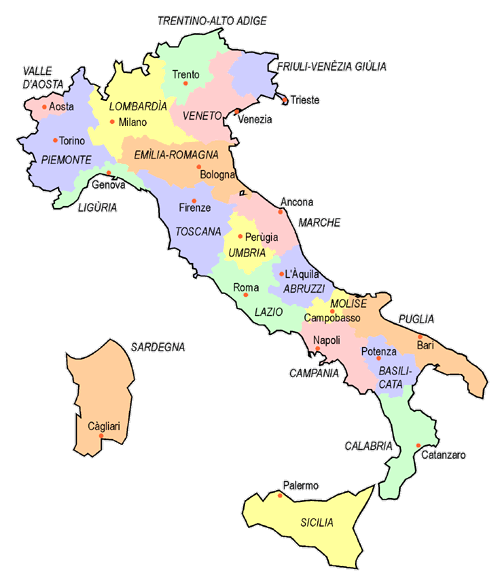mobile View, to the German Version tap the flag


- Molise
- Region of Italy
- own name: Molise
• Flag
• Meaning/Origin of the Flag
• Map of the regions of Italy
• Numbers and Facts
• History
• Origin of the Country's Name

Flag of Molise,
ratio = 2:3,
Source, by: Wikipedia (D)






The flag of Molise is single-coloured blue and shows in the middle the coat of arms of the region. This shows a red shield with a silvery left-oblique bar, and in the upper corner a silvery, eight-pointed star. The origin of the arms is not known, however, the star in the upper corner remembers the of County of Molise, in whose coat of arms it was the central element on the shield. There are also versions of the flag, which additionally show the inscription "REGIONE MOLISE" in red.
Source: Wikipedia (D),
Wikipedia (IT)

all names in Italian

Source: Volker Preuß

Area: 1.714 square miles
Inhabitants: 302.250 (2019)
Density of Population: 176 inh./sq.mi.
Capital: Campobasso, 49.000 inh. (2019)
official Language: Italian
Time Zone: GMT +1 h
Source: Wikipedia (D)

8th cent. B.C. · in the today's Molise settle the Samnites and Frentanians, which become allies of Rome in ca. 280 B.C.
410 A.D. · invasion of the Western Goth
476 · dismissal of the last Roman emperor Romulus Augustulus, end of the (West)Roman Empire, Molise belongs until 493 to the Empire of the Odoaker
to 565 · conquest by Byzantium (East Rome)
568/569 · the Langobardes capture a large part South Italy, so Campania, and establish there the Duchy of Benevent, Naples itself remains Byzantian
568/569 · the Langobards conquest a large part South Italy, so today's Molise, and establish there the Duchy of Benevent
774 · conquest of Northern Italy by the Franks, the Duchy of Benevent comes under Frankish supremacy
888 · after the extinction of the Carolingians the Duchy of Benevent disintegrates into several Langobardian principalities
1130 · Lower Italy with the Langobardian principalities, Naples Town, and the from the Byzantians left Norman territorities get united with the Norman Kingdom of Sicily, today's Molise remains connected with the Kingdom of Sicily to 1861 (resp. 1282–1815 with the Kingdom of Naples)
1194 · the Kingdom of Siciliy comes to the House of Hohenstaufen
1221 · the county of Molise is founded
1266 · the Kingdom of Siciliy comes to the house Anjou, Naples becomes perpetual capital of the Empire
1282 · "Sicilian Vespers" – by a uprising comes the Island of Sicily as a kingdom to the House of Aragón, Lower Italy remains as Kingdom of Sicily (unofficial: Kingdom of Naples) until 1442 at Anjou
1495 · the Kingdom of Naples gets a French estate
1529 · the Kingdom of Naples gets estate of the House of Habsburg
1556 · the Kingdom of Naples comes to the Spanish line of the House of Habsburg
1701–1714 · Spanish heritage succession war
1714 · peace treaty of Utrecht, the Kingdom of Naples and the Kingdom of Sardinia come to the House of the Austrian Habsburgs, Kingdom of Sicily comes to Savoy-Piedmont
1720 · the House of Savoy-Piedmont swaps with Austria Sicily in return for Sardinia, the Kingdom of Sicily comes in this way to the House of Habsburg (Kingdom of Naples-Sicily)
1734 · the House of Habsburg leaves the Kingdom of Naples-Sicily to the House of the Spanish Bourbons
January 1799 · invasion of French revolutionary troops, in the Kingdom of Naples the Bourbon rule ends, proclamation of the Parthenopean Republic, the king fled to Palermo, withdrawal of the French troops, the island of Sicily remains at the House of Bourbon
June 1799 · anti-French uprising, fall of the republic, the king returns
1806 · invasion of French troops under Napoléon I., Napoleón enthrones his brother Joseph Bonaparte as King of Naples
1808 · Joseph Bonaparte becomes King of Spain, Napoleón enthrones his brother-in-law Joachim Murat as King of Naples
1796 · Italy campaign of Napoléon, Sicily remains at the House of Bourbon
1815 · Congress of Vienna, reconstruction of Europe after the era of Napoléon, the Kingdom Sicily and the Kingdom of Naples come to the Spanish Bourbons
8th of December in 1816 · establish of the Kingdom of Two Sicilies under the Spanish Bourbons
1860 · Garibaldi's campaign against the Kingdom of Two Sicilies, the king exiles, Garibaldi acts as dictator
1861 · troops of the Kingdom of Sardinia-Piedmont invade, the County of Molise ends, the Kingdom of the Two Sicilies has to join the Kingdom of Italy
1947 · establishment of the Abruzzo region as administrative unit
1963 · Molise separates from the Abbruzzo region and forms an independent region
Source:
Brockhaus Konversationslexikon,
Atlas zur Geschichte,
Wikipedia (D)

The region of Molise is partially situated on the territory of the former Lombard Duchy of Benevento, which was founded in 571 shortly after the conquest by the Longobards. In 787 the duchy was subjugated by Charlemagne and was nominally converted to a principality. Benevento was conquered by the Normans in 1053 and ceded to the Papal States in 1077. The title was retained, however, Pope Alfonso V of Aragon was appointed as "Vicar of Benevento" by Pope Eugene IV in 1440, Pope Alexander VI. awarded Benevento as a duchy to his eldest son Juan Borgia. In 1798 Benevento came to Naples and in 1806 was given away by Napoleon to his minister Talleyrand, who assumed the title of "Prince of Benevento". The name of the region of Molise goes back to the county of Molise, which was founded in 1221 on the territory of the former Duchy of Benevento. The county ended in 1861 with the invasion of troops of the Kingdom of Sardinia-Piedmont. The name of the county goes back to the village of Molise, which is placed 12 km north-west of Campobasso. The city of Benevento is nowadays situated in Campania.
Source: Wikipedia (IT),
Brockhaus Konversationslexikon,
Volker Preuß


Kindly supported by:

![]()






